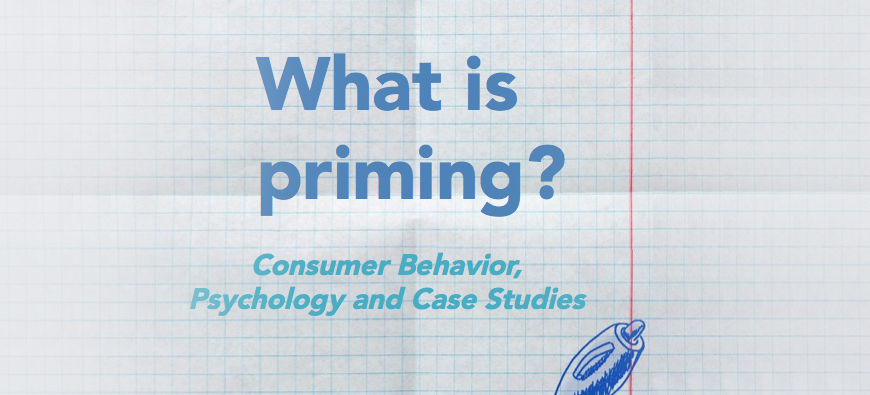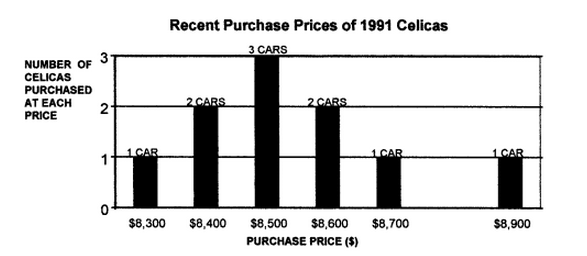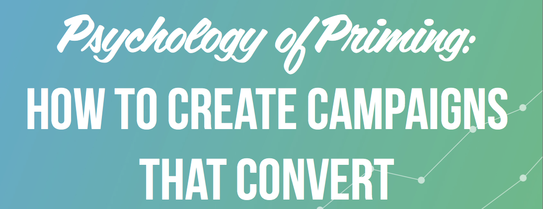What is Priming? A Psychological Look at Priming & Consumer Behavior

What is Priming? A Psychological Look at Priming & Consumer Behavior
As you’ve probably realized, various tenets of psychology are crucial to effective marketing. After all, psychology is about understanding human behavior and marketing is about applying that knowledge. There are many factors that influence this behavior, and while at least part of the human decision-making process is conscious, many of these factors influence behavior at a nonconscious level. As we have discussed previously on this blog, personality traits can serve as nonconscious motivations of behavior. In this post, I will introduce the psychological concept of priming, which can also have not-so-subtle influences on human behavior.
Part 1: What is priming?
A quick Wikipedia search will offer the following definition: “Priming is an implicit memory effect in which exposure to a stimulus influences a response to a later stimulus.”
Let’s unpack that.
‘implicit memory effect’ - whatever priming is, it is occurring below the surface of conscious thought.
‘exposure to a stimulus’ - this stimulus can be auditory, visual, tactile, etc. and we call it a ‘prime'.
‘influences a response’ - the aforementioned stimulus is affecting later behavior in someway
‘to a later stimulus’ - and it is affecting behavior in a certain environment
So, to put this all back together, priming is what we call it when exposure to some thing influences the behavior of an individual later on, without that individual being aware that the first thing is guiding their behavior to a certain extent.
Part 2: Psychological studies that illustrate the effects of priming
A) Word Completion Task
In the standard variation of this task, participants are given a long list of words to read. The list is long enough that participants would not easily be able to memorize it and they also do not know that the words might be helpful later on. Then, the participants are asked to complete words that have some letters left out. For example _EX_G_ _, which can be completed to HEXAGON. Participants who read hexagon on the list of words earlier are more likely to get this task correct and also complete it more quickly. Another variant of this task asks participants to complete simple words that could be completed in various ways. For example D_ _ K could be complete as DORK or DARK. Participants responses are dependent not only on whether they had read the word earlier, but also by thematic scheme of the words. For example if they had read the words NIGHT, MOON and SLEEP, they would be more likely to complete it as DARK.
In these examples, the first list of words serves as the prime to influence later behavior on the word completion task.
B) Lexical Decision Task
In this task, participants are told to decide whether a word they are shown is real or made-up. The made up words follow general spelling and phonetic rules (ex. ‘ksjfhd’ would not appear on the test, but ‘blargh’ might). The participants are told to respond as quickly, but as accurately as possible and are scored along these two dimensions. It has been noted that when a participant has seen the real word recently they are faster to classify it as real. Additionally, the classification is also faster if the real word relates thematically to other words the participants have seen recently. For example, if the participants had been studying a list of medically related words they might classify ‘NURSE’ as a real word faster than if they had been studying school related words.
The explanation often offered for this is that, when words are read, a ‘schema’ relating those words thematically, is activated in the brain. For example, if you read the words HOMEWORK, STUDY and EXAM, the ‘school’ schema in your brain might be activated. Later, when you are asked to determine whether BOOK is a real word, your brain gets to skip the step in the word-classification process that requires thematic activation and thus the processing speed is faster. In other words, because your brain was already primed to be thinking about school, it was, on some level, already thinking about the word book.
C) Stereotyping
Several studies have shown that priming can have an effect on social behavior as well as cognitive behavior. MotiveMetrics advisor, John Bargh, worked to explore this in a study consisting of three experiments. In the first experiment they primed participants with words related to elderly people, but never mentioned age or disabilities of any kind. They found that these participants actually walked slower when leaving the experiment than did their control group peers.
In the second experiment, they found that participants who had been primed with words relating to rudeness were more likely to interrupt the experimenter, and in the third experiment they found that “participants for whom the African American stereotype was primed subliminally reacted with more hostility to a vexatious request of the experimenter.” Priming is also believed to be a potential mechanism behind stereotype threat.
Part 3: Priming in marketing
Although many primes work better when the stimuli are of the same modality (i.e. both spoken, or both written, or both heard, etc.), they can still be effective in other situations, which has important implications for marketing.
A) Music and Wine
In 1999, North et al. conducted a field experiment in a grocery store. For two weeks, stereotypically French and German music were played on alternating days and the amount of French wine versus German wine sold was measured. Additionally, purchasers of wine were asked to fill out a brief survey, the results of which revealed that they were “unaware of [the] effects of music on their product choices.” As you can probably predict based on the topic of this blog, more French wine was sold on days when French music was playing and more German wine was sold on the German music days. A simple, auditory prime had a significant effect on buying behavior, that consumers were not consciously aware of!
In another study by North (2011) it was found that participants described the taste of wines differently, depending on what type of music was being played. More specifically, they had the tendency to describe wines in accordance with what type of music was being played. They chose 4 pieces of music which corresponded to 4 sets of characteristics: Carmina Burana by Orff (powerful and heavy), Waltz of the Flowers from Tchaikovsky's ‘Nutcracker’ (subtle and refined), Just Can't Get Enough by Nouvelle Vague (zingy and refreshing), and Slow Breakdown by Michael Brook (mellow and soft).
Participants drank wine -- the same wine -- while one of these played in the background. Those who heard Carmina Burana were more likely to describe the wine as powerful and heavy, those who heard Waltz of the Flowers were more likely to describe it as subtle and refined, and so on. Once again, this is an example of a subtle cue dictating the outcome of behavior.
B) “Less Pain, Same Gain”
A question that has always and will always plague producers and retailers is how to charge as much as possible while not decreasing customer satisfaction. Turns out, priming can offer an insight into how to do just that. In their 1999 study, Maxwell et al. told participants to imagine they were buying a used car and gave them the following data regarding prices that similar vehicles had sold for:

Additionally, one group of participants was primed for ‘fairness’ by being asked to state what the lowest and highest fair prices for the car would be. Since all participants played the role of the buyer, this manipulation forced them to consider fairness from both sides of the deal. All participants then ‘bargained’ over the price for the car with who they thought was a real person but was actually a computer programmed to respond with an amount of 60% more than whatever the participant stated. The results of the bargaining process revealed that “the range of prices that fairness-primed buyers considered fair was higher than the range considered acceptable” and the first concession (i.e. step in the bargaining process after the first bid) was 24% larger for the fairness-primed group than for the control group. Lastly, the fairness-primed group reported that the eventual settlement exceeded their expectations whereas the control group reported that it fell short of their expectations. This all reveals that, when primed for fairness, consumer behavior is influenced such that consumers act more cooperatively and have an increased sense of satisfaction, regardless of the price paid.
C) “What We See Makes Us Who We Are”
In a 2001 study, Forehand and Deshpandé explored the impact of ‘ethnic primes’ on participants’ behavior and response to advertisements. Their study pool consisted of both Asian and Caucasian participants who were asked to fill out a short questionnaire and watch a short television tape which included brief news segments and advertisements. In the experimental group, one of these advertisements was for hair products specifically designed for “Asian hair” -- this was considered the ethnic prime. They found that consumers with an ethnicity that matched the ethnicity used in the ethnic prime (i.e. Asians) were more likely to mention their ethnicity when asked to describe themselves (demonstrating that the ad primed ethnic self-awareness). Furthermore, one of the other advertisements watched was performed by an Asian spokesperson. Asians who had been exposed to the ethnic prime advertisement reported liking this spokesperson more than Caucasians who had been exposed to the ethnic prime. In other words, there was a main effect of ethnic self-awareness at play, not just an effect of a prime.
This goes to show that activation of this self awareness “may directly influence consumer reactions to group-relevant information” and therefore may influence consumer behavior by priming consumers to receive and interpret advertisement information more positively.
The fundamentals of priming provide a simple view into one aspect of nonconscious behavior. The clear implications of priming on our daily behavior, poses some great questions for marketers: How can we best use priming in an ethical way to influence purchasing decisions? How significant is the distribution channel to the success of an emerging product or brand? How can marketers and consumer insight teams utilize psychology for a positive brand experience?

